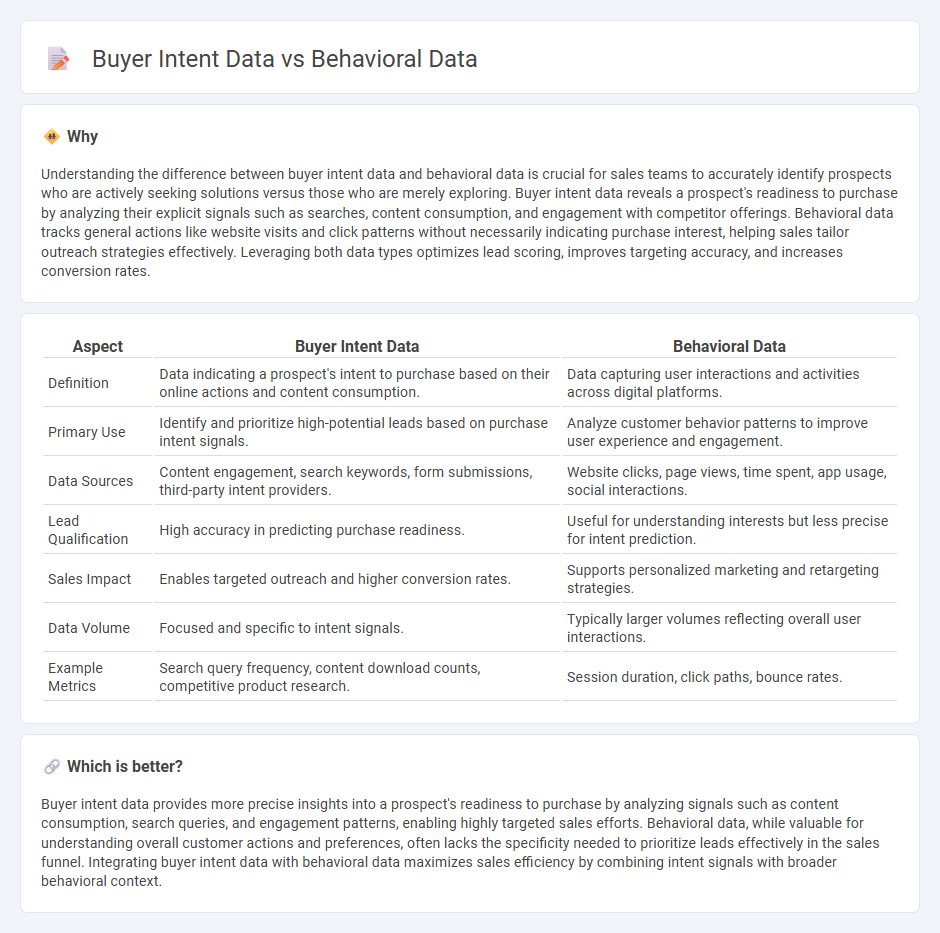
Buyer intent data reveals potential customers' readiness to purchase by analyzing signals such as content consumption, search queries, and engagement with marketing materials. Behavioral data tracks actions like click patterns, website navigation, and transaction history to understand user preferences and predict future behavior. Explore the key differences between these data types to enhance sales strategies and target prospects more effectively.
Why it is important
Understanding the difference between buyer intent data and behavioral data is crucial for sales teams to accurately identify prospects who are actively seeking solutions versus those who are merely exploring. Buyer intent data reveals a prospect's readiness to purchase by analyzing their explicit signals such as searches, content consumption, and engagement with competitor offerings. Behavioral data tracks general actions like website visits and click patterns without necessarily indicating purchase interest, helping sales tailor outreach strategies effectively. Leveraging both data types optimizes lead scoring, improves targeting accuracy, and increases conversion rates.
Comparison Table
| Aspect | Buyer Intent Data | Behavioral Data |
|---|---|---|
| Definition | Data indicating a prospect's intent to purchase based on their online actions and content consumption. | Data capturing user interactions and activities across digital platforms. |
| Primary Use | Identify and prioritize high-potential leads based on purchase intent signals. | Analyze customer behavior patterns to improve user experience and engagement. |
| Data Sources | Content engagement, search keywords, form submissions, third-party intent providers. | Website clicks, page views, time spent, app usage, social interactions. |
| Lead Qualification | High accuracy in predicting purchase readiness. | Useful for understanding interests but less precise for intent prediction. |
| Sales Impact | Enables targeted outreach and higher conversion rates. | Supports personalized marketing and retargeting strategies. |
| Data Volume | Focused and specific to intent signals. | Typically larger volumes reflecting overall user interactions. |
| Example Metrics | Search query frequency, content download counts, competitive product research. | Session duration, click paths, bounce rates. |
Which is better?
Buyer intent data provides more precise insights into a prospect's readiness to purchase by analyzing signals such as content consumption, search queries, and engagement patterns, enabling highly targeted sales efforts. Behavioral data, while valuable for understanding overall customer actions and preferences, often lacks the specificity needed to prioritize leads effectively in the sales funnel. Integrating buyer intent data with behavioral data maximizes sales efficiency by combining intent signals with broader behavioral context.
Connection
Buyer intent data and behavioral data are interconnected through the analysis of online activities that reveal potential customers' readiness to purchase. Behavioral data captures real-time interactions such as website visits, content engagement, and search queries, which feed into buyer intent models to identify leads with high conversion probability. Leveraging this integrated data enables sales teams to prioritize prospects and tailor outreach strategies effectively.
Key Terms
Actions Tracked
Behavioral data captures a wide range of user actions such as page views, clicks, and time spent on site, providing insights into general engagement patterns. Buyer intent data zeroes in on specific signals indicating purchase readiness, including product searches, content downloads, and cart activity. Explore how leveraging these distinct types of actions tracked can refine your marketing strategies and boost conversion rates.
Purchase Signals
Behavioral data tracks user actions such as clicks, page visits, and time spent on product pages, providing insights into general engagement patterns. Buyer intent data specifically captures signals like product comparisons, cart additions, and search queries indicating a higher likelihood of purchase. Discover how leveraging these purchase signals can enhance targeted marketing strategies and boost conversion rates.
Predictive Analytics
Behavioral data captures user actions such as clicks, page views, and time spent on site, while buyer intent data identifies signals indicating a potential customer's readiness to purchase through interactions like content downloads or search queries. Predictive analytics leverages both data types to forecast future buying behavior, enhance lead scoring, and tailor marketing strategies for higher conversion rates. Explore how integrating behavioral and buyer intent data can revolutionize your predictive analytics approach.
Source and External Links
What is Behavioral Data & Why is it Important? - Behavioral data captures how customers interact with a business through actions like page views, clicks, and purchases, providing valuable insights that help personalize experiences and optimize customer journeys using data from websites, apps, and social media platforms.
Understanding Behavioral Data: A Comprehensive Guide - Behavioral data records user interactions within products or services, revealing real, actionable habits and preferences used to improve user engagement, product decisions, and customer retention.
What is Behavioral Data? The Complete Guide - This data includes interaction-based activities such as clicks, scrolls, form submissions, and video watch times, which are tracked to analyze how users engage with digital interfaces.
 dowidth.com
dowidth.com